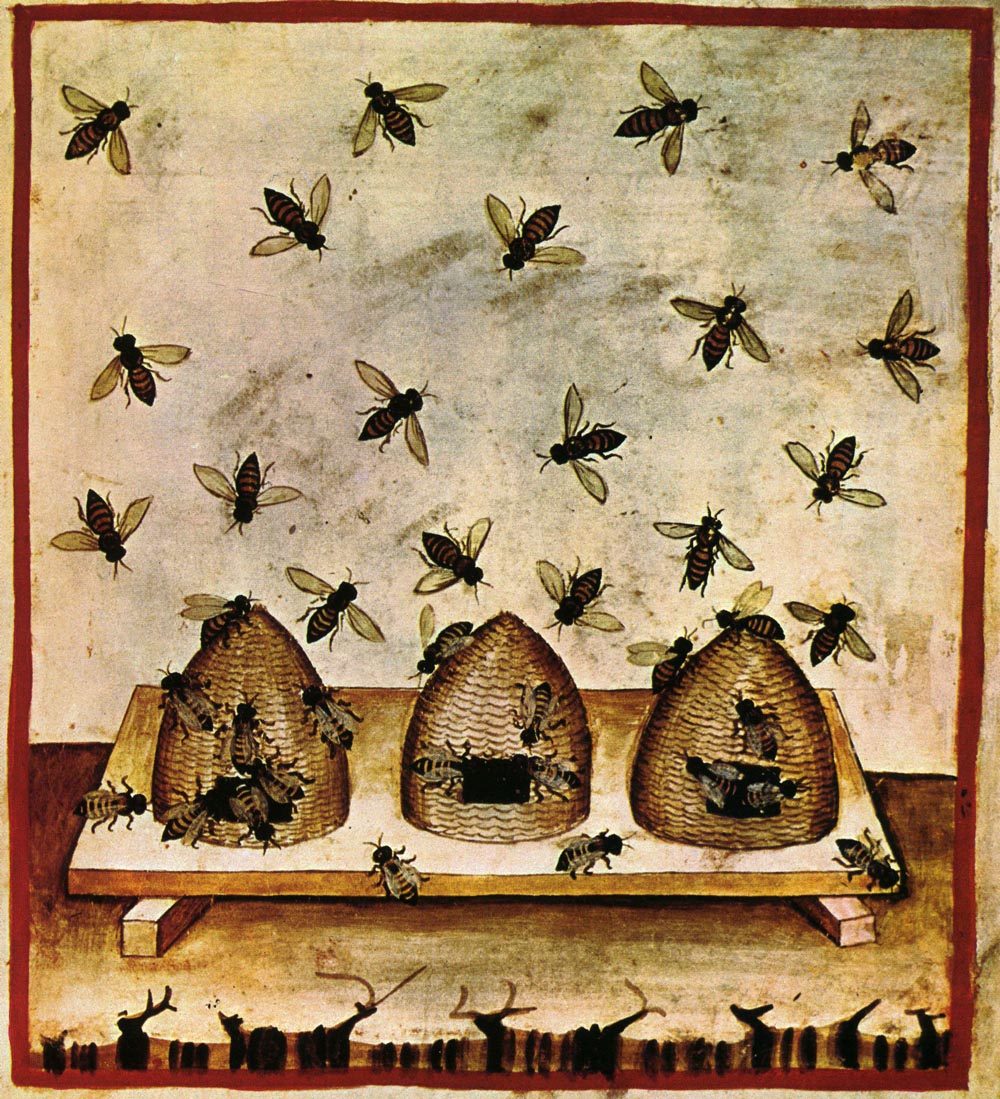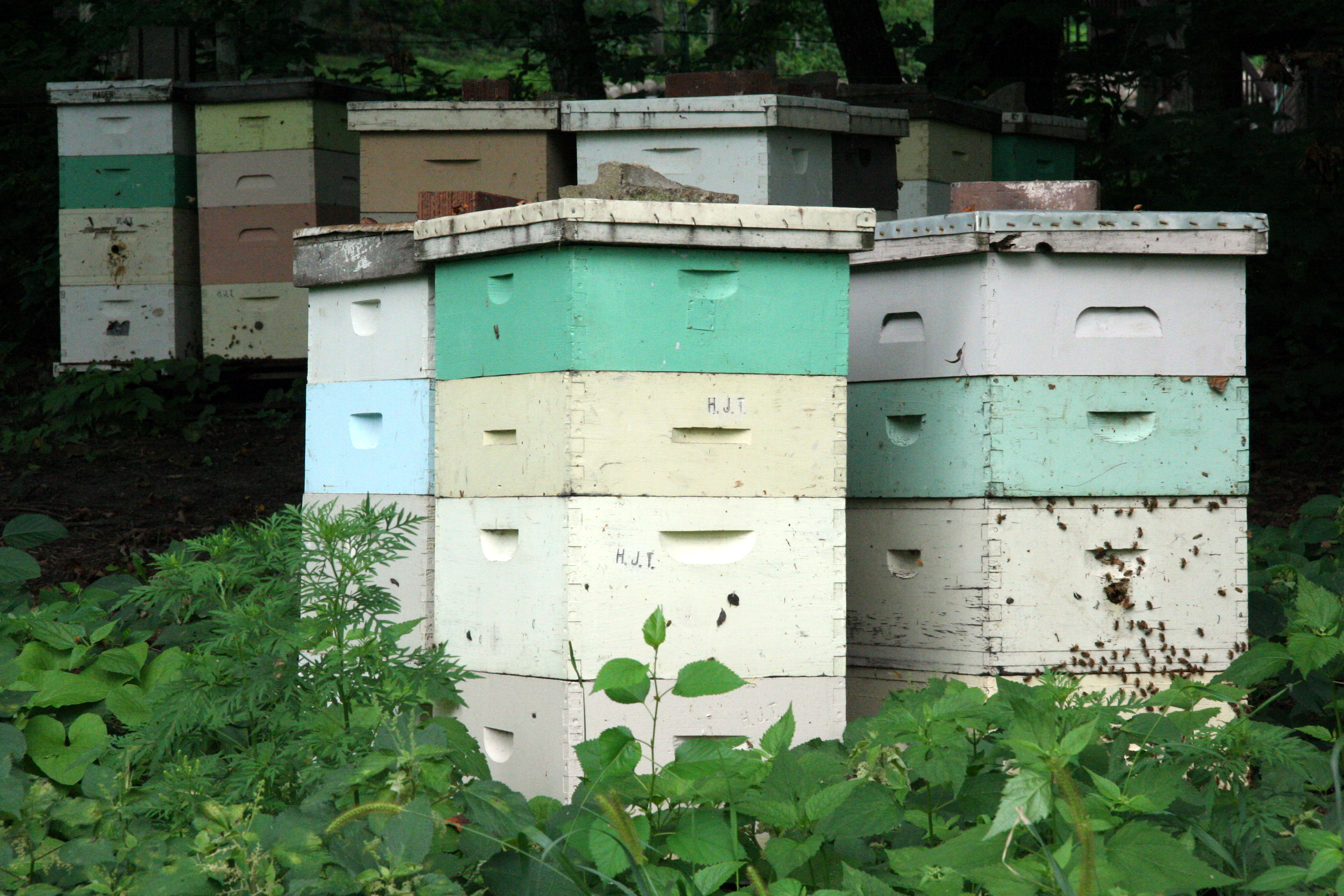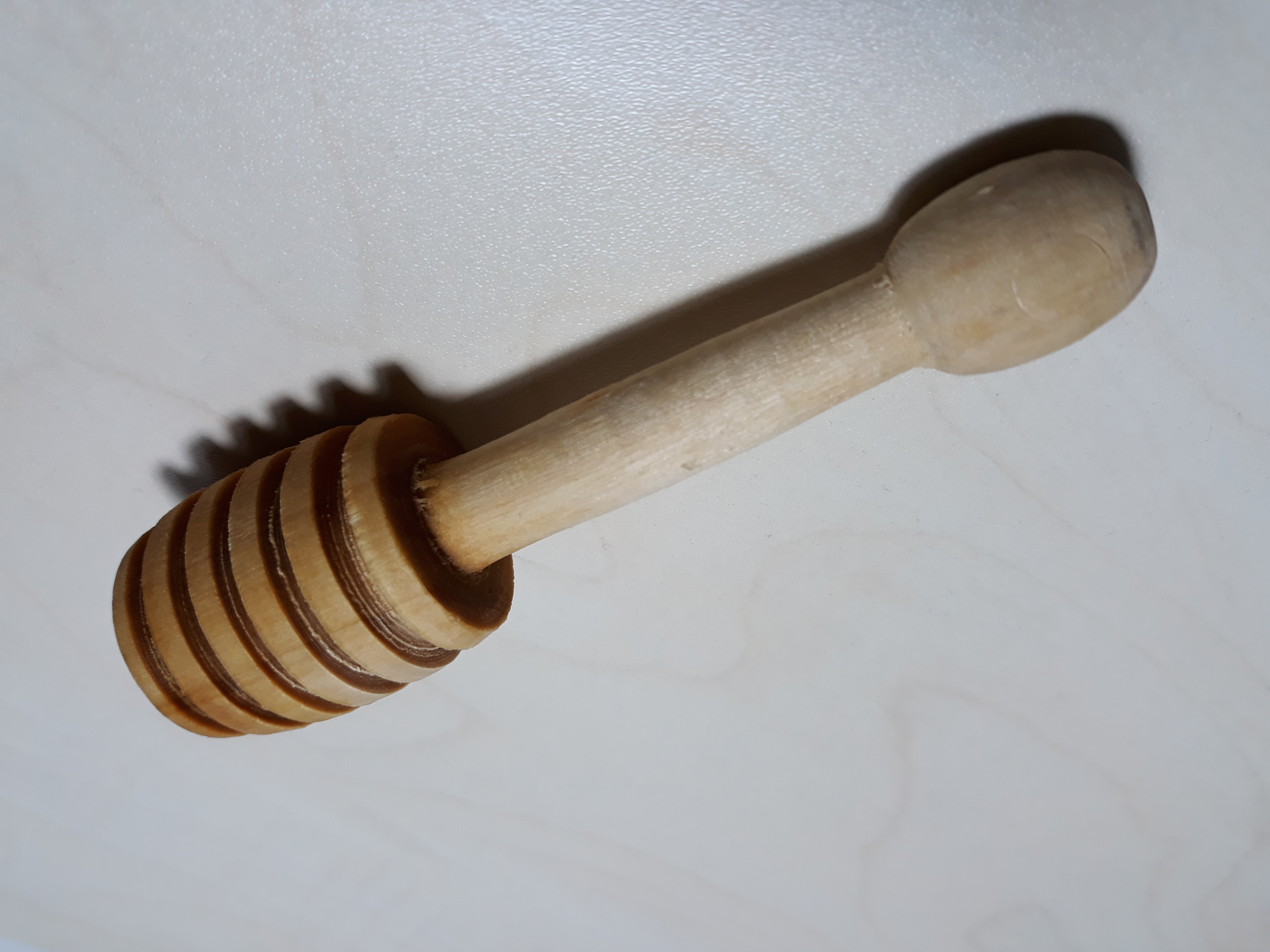|
Honey
Honey is a sweet and viscous substance made by several bees, the best-known of which are honey bees. Honey is made and stored to nourish bee colonies. Bees produce honey by gathering and then refining the sugary secretions of plants (primarily floral nectar) or the secretions of other insects, like the honeydew of aphids. This refinement takes place both within individual bees, through regurgitation and enzymatic activity, as well as during storage in the hive, through water evaporation that concentrates the honey's sugars until it is thick and viscous. Honey bees stockpile honey in the hive. Within the hive is a structure made from wax called honeycomb. The honeycomb is made up of hundreds or thousands of hexagonal cells, into which the bees regurgitate honey for storage. Other honey-producing species of bee store the substance in different structures, such as the pots made of wax and resin used by the stingless bee. Honey for human consumption is collected from ... [...More Info...] [...Related Items...] OR: [Wikipedia] [Google] [Baidu] |
Honey Bee
A honey bee (also spelled honeybee) is a eusocial flying insect within the genus ''Apis'' of the bee clade, all native to Afro-Eurasia. After bees spread naturally throughout Africa and Eurasia, humans became responsible for the current cosmopolitan distribution of honey bees, introducing multiple subspecies into South America (early 16th century), North America (early 17th century), and Australia (early 19th century). Honey bees are known for their construction of wiktionary:perennial, perennial Colony (biology), colonial nests from Beeswax, wax, the large size of their colonies, and surplus production and storage of honey, distinguishing their hives as a prized foraging target of many animals, including honey badgers, bears and human hunter-gatherers. Only eight surviving species of honey bee are recognized, with a total of 43 subspecies, though historically 7 to 11 species are recognized. Honey bees represent only a small fraction of the roughly 20,000 known species of bees ... [...More Info...] [...Related Items...] OR: [Wikipedia] [Google] [Baidu] |
Beekeeping
Beekeeping (or apiculture) is the maintenance of bee colonies, commonly in man-made beehives. Honey bees in the genus ''Apis'' are the most-commonly-kept species but other honey-producing bees such as '' Melipona'' stingless bees are also kept. Beekeepers (or apiarists) keep bees to collect honey and other products of the hive: beeswax, propolis, bee pollen, and royal jelly. Pollination of crops, raising queens, and production of package bees for sale are other sources of beekeeping income. Bee hives are kept in an apiary or "bee yard". The keeping of bees by humans, primarily for honey production, began around 10,000 years ago. Georgia is known as the "cradle of beekeeping" and the oldest honey ever found comes from that country. The 5,500-year-old honey was unearthed from the grave of a noblewoman during archaeological excavations in 2003 near the town Borjomi. Ceramic jars found in the grave contained several types of honey, including linden and flower honey. Domes ... [...More Info...] [...Related Items...] OR: [Wikipedia] [Google] [Baidu] |
Meliponiculture
Stingless bees, sometimes called stingless honey bees or simply meliponines, are a large group of bees (about 550 described species), comprising the tribe Meliponini (or subtribe Meliponina according to other authors). They belong in the family Apidae, and are closely related to common honey bees, carpenter bees, orchid bees, and bumblebees. Meliponines have stingers, but they are highly reduced and cannot be used for defense, though these bees exhibit other defensive behaviors and mechanisms. Meliponines are not the only type of bee incapable of stinging: all male bees and many female bees of several other families, such as Andrenidae, also cannot sting. Some stingless bees have powerful mandibles and can inflict painful bites. Geographical distribution Stingless bees can be found in most tropical or subtropical regions of the world, such as Australia, Africa, Southeast Asia, and tropical America.Michener, C D. ''The bees of the World''. Johns Hopkins University Press, 972 p ... [...More Info...] [...Related Items...] OR: [Wikipedia] [Google] [Baidu] |
Stingless Bee
Stingless bees, sometimes called stingless honey bees or simply meliponines, are a large group of bees (about 550 described species), comprising the tribe Meliponini (or subtribe Meliponina according to other authors). They belong in the family Apidae, and are closely related to common honey bees, carpenter bees, orchid bees, and bumblebees. Meliponines have stingers, but they are highly reduced and cannot be used for defense, though these bees exhibit other defensive behaviors and mechanisms. Meliponines are not the only type of bee incapable of stinging: all male bees and many female bees of several other families, such as Andrenidae, also cannot sting. Some stingless bees have powerful mandibles and can inflict painful bites. Geographical distribution Stingless bees can be found in most tropical or subtropical regions of the world, such as Australia, Africa, Southeast Asia, and tropical America.Michener, C D. ''The bees of the World''. Johns Hopkins University Press, ... [...More Info...] [...Related Items...] OR: [Wikipedia] [Google] [Baidu] |
Beehive
A beehive is an enclosed structure in which some honey bee species of the subgenus ''Apis'' live and raise their young. Though the word ''beehive'' is commonly used to describe the nest of any bee colony, scientific and professional literature distinguishes ''nest'' from ''hive''. ''Nest'' is used to discuss colonies that house themselves in natural or artificial cavities or are hanging and exposed. ''Hive'' is used to describe an artificial/man-made structure to house a honey bee nest. Several species of ''Apis'' live in colonies, but for honey production the western honey bee (''Apis mellifera'') and the eastern honey bee (''Apis cerana'') are the main species kept in hives. The nest's internal structure is a densely packed group of hexagonal prismatic cells made of beeswax, called a honeycomb. The bees use the cells to store food (honey and pollen) and to house the brood (eggs, larvae, and pupae). Beehives serve several purposes: production of honey, pollination of nea ... [...More Info...] [...Related Items...] OR: [Wikipedia] [Google] [Baidu] |
Beehive
A beehive is an enclosed structure in which some honey bee species of the subgenus ''Apis'' live and raise their young. Though the word ''beehive'' is commonly used to describe the nest of any bee colony, scientific and professional literature distinguishes ''nest'' from ''hive''. ''Nest'' is used to discuss colonies that house themselves in natural or artificial cavities or are hanging and exposed. ''Hive'' is used to describe an artificial/man-made structure to house a honey bee nest. Several species of ''Apis'' live in colonies, but for honey production the western honey bee (''Apis mellifera'') and the eastern honey bee (''Apis cerana'') are the main species kept in hives. The nest's internal structure is a densely packed group of hexagonal prismatic cells made of beeswax, called a honeycomb. The bees use the cells to store food (honey and pollen) and to house the brood (eggs, larvae, and pupae). Beehives serve several purposes: production of honey, pollination of nea ... [...More Info...] [...Related Items...] OR: [Wikipedia] [Google] [Baidu] |
Honeycomb
A honeycomb is a mass of hexagonal prismatic wax cells built by honey bees in their nests to contain their larvae and stores of honey and pollen. Beekeepers may remove the entire honeycomb to harvest honey. Honey bees consume about of honey to secrete of wax, and so beekeepers may return the wax to the hive after harvesting the honey to improve honey outputs. The structure of the comb may be left basically intact when honey is extracted from it by uncapping and spinning in a centrifugal machine, more specifically a honey extractor. If the honeycomb is too worn out, the wax can be reused in a number of ways, including making sheets of comb foundation with hexagonal pattern. Such foundation sheets allow the bees to build the comb with less effort, and the hexagonal pattern of worker-sized cell bases discourages the bees from building the larger drone cells. Fresh, new comb is sometimes sold and used intact as comb honey, especially if the honey is being spread on bread rather th ... [...More Info...] [...Related Items...] OR: [Wikipedia] [Google] [Baidu] |
Honeydew (secretion)
Honeydew is a sugar-rich sticky liquid, secreted by aphids and some scale insects as they feed on plant sap. When their mouthpart penetrates the phloem, the sugary, high-pressure liquid is forced out of the anus of the aphid. Honeydew is particularly common as a secretion in hemipteran insects and is often the basis for trophobiosis. Some caterpillars of Lycaenidae butterflies and some moths also produce honeydew. Honeydew producing insects, like cicadas, pierce phloem ducts to access the sugar rich sap. The sap continues to bleed after the insects have moved on, leaving a white sugar crust called manna. Ants may collect, or "milk", honeydew directly from aphids and other honeydew producers, which benefit from their presence due to their driving away predators such as lady beetles or parasitic wasps—see ''Crematogaster peringueyi''. Animals and plants in a mutually symbiotic arrangement with ants are called Myrmecophiles. In Madagascar, some gecko species in the genera ''Phe ... [...More Info...] [...Related Items...] OR: [Wikipedia] [Google] [Baidu] |
Honey Dipper
A honey dipper is a kitchen utensil used to collect viscous liquid (generally honey Honey is a sweet and viscous substance made by several bees, the best-known of which are honey bees. Honey is made and stored to nourish bee colonies. Bees produce honey by gathering and then refining the sugary secretions of plants (primar ...) from a container, which it then exudes to another location. It is often made of turned wood. Besides the handle, the tool consists of equally spaced grooves. Often, the grooves descend in circumference on each new groove. Use One method of using the tool is to dip the grooved end into the liquid, then slowly twirl the handle between the thumb and fingers while in transport, as the concentric grooves help to minimize dripping. It is commonly used to drizzle honey on bread, biscuits, or other foods of that nature. The tool is sometimes made of plastic or glass. In popular culture The mascot of Honey Nut Cheerios, "BuzzBee", has carried var ... [...More Info...] [...Related Items...] OR: [Wikipedia] [Google] [Baidu] |
Sugar
Sugar is the generic name for sweet-tasting, soluble carbohydrates, many of which are used in food. Simple sugars, also called monosaccharides, include glucose, fructose, and galactose. Compound sugars, also called disaccharides or double sugars, are molecules made of two bonded monosaccharides; common examples are sucrose (glucose + fructose), lactose (glucose + galactose), and maltose (two molecules of glucose). White sugar is a refined form of sucrose. In the body, compound sugars are hydrolysed into simple sugars. Longer chains of monosaccharides (>2) are not regarded as sugars, and are called oligosaccharides or polysaccharides. Starch is a glucose polymer found in plants, the most abundant source of energy in human food. Some other chemical substances, such as glycerol and sugar alcohols, may have a sweet taste, but are not classified as sugar. Sugars are found in the tissues of most plants. Honey and fruits are abundant natural sources of simple sugars. Sucr ... [...More Info...] [...Related Items...] OR: [Wikipedia] [Google] [Baidu] |
Hexagon
In geometry, a hexagon (from Greek , , meaning "six", and , , meaning "corner, angle") is a six-sided polygon. The total of the internal angles of any simple (non-self-intersecting) hexagon is 720°. Regular hexagon A ''regular hexagon'' has Schläfli symbol and can also be constructed as a truncated equilateral triangle, t, which alternates two types of edges. A regular hexagon is defined as a hexagon that is both equilateral and equiangular. It is bicentric, meaning that it is both cyclic (has a circumscribed circle) and tangential (has an inscribed circle). The common length of the sides equals the radius of the circumscribed circle or circumcircle, which equals \tfrac times the apothem (radius of the inscribed circle). All internal angles are 120 degrees. A regular hexagon has six rotational symmetries (''rotational symmetry of order six'') and six reflection symmetries (''six lines of symmetry''), making up the dihedral group D6. The longest diagonals ... [...More Info...] [...Related Items...] OR: [Wikipedia] [Google] [Baidu] |
Nectar
Nectar is a sugar-rich liquid produced by plants in glands called nectaries or nectarines, either within the flowers with which it attracts pollinating animals, or by extrafloral nectaries, which provide a nutrient source to animal mutualists, which in turn provide herbivore protection. Common nectar-consuming pollinators include mosquitoes, hoverflies, wasps, bees, butterflies and moths, hummingbirds, honeyeaters and bats. Nectar plays a crucial role in the foraging economics and evolution of nectar-eating species; for example, nectar foraging behavior is largely responsible for the divergent evolution of the African honey bee, ''A. m. scutellata'' and the western honey bee. Nectar is an economically important substance as it is the sugar source for honey. It is also useful in agriculture and horticulture because the adult stages of some predatory insects feed on nectar. For example, a number of parasitoid wasps (e.g. the social wasp species '' Apoica flavissima' ... [...More Info...] [...Related Items...] OR: [Wikipedia] [Google] [Baidu] |









